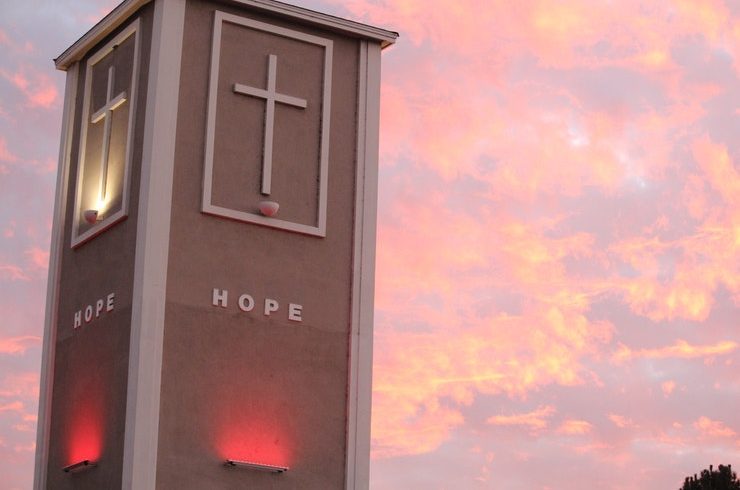“There so much love in here…you have to come in to get it…”
The woman who said this to me was at the end of a struggle involving a domestic dispute. I spent a lot of time helping her navigate the issue, since I was a staff member at the church we attended. Her statement was an expression of gratitude for all the support she received from our church family. But I couldn’t stop ruminating on the 2nd half of her statement: “you have to come in to get [the love].”
The struggle to maintain an organizational structure (labeled a 501c3 by the IRS) while simultaneously maintaining an organic, spontaneous, Spirit-directed, missional presence is very real. As a church planter, years after this conversation, I would learn how hard it is to resist the inevitable inertia of being “established.” In our initial summer of outreach, my ministry partner-husband and I could be found on a corner in our target neighborhood twice each week passing out hot dogs and making new relationships. We were consistently looking for ways to engage neighbors outside of the walls of the building where we met every Sunday.
But time and routine have a way of fossilizing the adventurer spirit that gives birth to any start-up, even a church. In our naïveté, we thought, somehow, that this this inertia could be resisted, if not overcome. We were wrong.
Somewhere on our journey, our “gathered-to -be-scattered” rhythm of meeting on Sundays and going out as ambassadors for Jesus gave way to the inertia of the established weekly meeting. Slowly, we became leaders who spoke of “going to church,” instead of “being the church.” We invited neighbors to “join us” at events instead of going to be with our neighbors. We were maintaining our organizational rhythm, our 501c3, with membership, weekly gatherings, and financial contributions. There was a lot of love between us all, but you had to come in to get it. Time and routine have a way of fossilizing the adventurer spirit that gives birth to any start-up, even a church. Click To Tweet
Please don’t misunderstand me. I know that successful, non-profit, 501c3 organizations must build rhythms and habits to remain healthy over the long haul. But, sometimes, these rhythms and habits generate expectations and traditions that obscure mission. Here are some thoughts to help you evaluate your church’s missional and organizational character.
The church is messy; Successful 501c3 organizations avoid messy situations.
Even a superficial reading of the book of Acts reveals that early Jesus followers were making it up as they went along. They fumbled forward, disagreeing with each other and, in one case, refusing to travel together. They questioned each other’s decision-making and weren’t always sure they were doing the right thing.
One of my favorite snapshots from the life of the early church is in Acts 15. In this scene the church is debating the question of whether those outside of the Jewish culture needed to follow the custom of circumcision to be included in the family of God. The church leaders have a debate with honest input and then reach a conclusion in Acts 15:28 that begins with the phrase “It seems good to us and the Holy Spirit… .”
Can you imagine this playing out in any of the non-profits that you are connected too? Would you contribute money to an organization with senior leadership communicating that a decision “seemed” OK? As ministry leaders, we have to discern when the pull of the 501c3 compromises the beautiful witness of the Spirit uniting unlikely partners who make less than certain decisions in the work of building the Beloved Community of God. We are privileged to be a part of a messy work and simultaneously tempted, in the world of non-profit efficiency, to hide that mess behind layers of polish and process. Polish and layers of process might make a 501c3 organization look attractive, but the same polish can weaken your message as a church. Polish and layers of process might make a 501c3 organization look attractive, but the same polish can weaken your message as a church. Click To Tweet
The work of the church is risky; A 501c3 finds success by mitigating risk.
The Apostle Paul, the primary marketing director for the church, is a well-known, former murderer. The Apostle Peter leads the church to accept Gentiles, specifically Roman oppressors, into the family of Jesus. And all the lead preachers for this newly established organization refuse to obey the instruction of law enforcement and persist in preaching about Jesus, even after being warned to stop making such trouble. As a former non-profit Executive Director, I can honestly say that these are some bad employees. In a typical 501c3, these men and women would be a threat to an organization’s stability.
But liability and risk abound in the work of loving our neighbors in the way of Jesus. We are to get close to the ‘untouchable’. We are called to throw our lot in with those at the bottom of society’s hierarchy. We follow the Spirit, not to the glamorous, but to the weak and frail. In a nation built on “bootstrap” mythology, no one wants to be identified with a project that is likely to fail. I can say, from experience in my early years as an urban church planter, that being identified as a risky venture makes it hard to raise funding, even among Jesus followers who support your mission. In your work as a ministry leader among the “least of these,” the risk of failure is as likely (or even more likely) than success. This puts you in good company with Jesus and all of his losing, ragtag rebels throughout history, but it doesn’t necessarily make for a good performance evaluation in your average non-profit.
Sometimes the 501c3 needs to die to set the church free
This is not a hard and fast rule. But it is true. I fear, lately, that some of our church revitalization programs are fueled, primarily, by the fear that our favorite congregation will die. And, since it has always been around, we believe that our favorite congregation should always be around. But churches adapting to survive aren’t necessarily the same as churches transforming to thrive. There’s a difference between thriving and surviving and that difference is best discerned in community with guidance from the Spirit. When the time comes, non-profit, 501c3 organizations that position themselves for a “good death” become seeds for new life in a movement or a community. Similarly, churches can position themselves for a good death, when the Spirit leads them to break free from the constraints of “what we’ve always been” in order to let the adventure that is the Kingdom of God continue. And, while it’s hard to say goodbye to the church of our youth, or the church where our kids were born, we can learn to let go when it’s time, trusting that the heart of the Gospel story is true. A good death, leads, by the power of the Spirit, to new life.
Sometimes the church needs the 501c3 to facilitate her mission
When I was a new church planter, I often held the formalities and rhythms of running an organization to be a necessary evil. Honestly, I thought these formalities were more evil than necessary. But nearly ten years later, I understand how naïve I was. I needed the rhythms that kept our 501c3 healthy so I could be free to dream and move forward in mission. Truthfully, it takes a lot of energy to maintain an organization while also keeping that same organization ready for a Spirit-led mission. But it’s important to remember that the habits that make a good 501c3 are not all that are necessary to build a strong, missional church. The church, led by the Spirit, is that wild, and often unruly impulse that challenges the powerful, calls out injustice, and breaks the barriers that keep us apart. Maturing as a leader requires giving attention to both, this impulse, and the organizational practices that will free you to follow this impulse.
I’m tempted to close this post with a call for balance between your habits as an organizational leader and the impulse of the Spirit. Instead, let me suggest sensitivity as a better paradigm. As we cultivate sensitivity to the call of the Spirit, we’ll know when to resist the inevitable inertia that envelops every organization and choose, instead to follow the messy and risky impulse of the Spirit, so that coming in to church to get the love isn’t the only option our neighbors have.
Now it’s your turn. How do you resist organizational inertia in your ministry? What practices help you cultivate sensitivity to the Spirit’s impulse? How do you resist organizational inertia in your ministry? What practices help you cultivate sensitivity to the Spirit's impulse? Click To Tweet












Missio Alliance Comment Policy
The Missio Alliance Writing Collectives exist as a ministry of writing to resource theological practitioners for mission. From our Leading Voices to our regular Writing Team and those invited to publish with us as Community Voices, we are creating a space for thoughtful engagement of critical issues and questions facing the North American Church in God’s mission. This sort of thoughtful engagement is something that we seek to engender not only in our publishing, but in conversations that unfold as a result in the comment section of our articles.
Unfortunately, because of the relational distance introduced by online communication, “thoughtful engagement” and “comment sections” seldom go hand in hand. At the same time, censorship of comments by those who disagree with points made by authors, whose anger or limited perspective taints their words, or who simply feel the need to express their own opinion on a topic without any meaningful engagement with the article or comment in question can mask an important window into the true state of Christian discourse. As such, Missio Alliance sets forth the following suggestions for those who wish to engage in conversation around our writing:
1. Seek to understand the author’s intent.
If you disagree with something the an author said, consider framing your response as, “I hear you as saying _________. Am I understanding you correctly? If so, here’s why I disagree. _____________.
2. Seek to make your own voice heard.
We deeply desire and value the voice and perspective of our readers. However you may react to an article we publish or a fellow commenter, we encourage you to set forth that reaction is the most constructive way possible. Use your voice and perspective to move conversation forward rather than shut it down.
3. Share your story.
One of our favorite tenants is that “an enemy is someone whose story we haven’t heard.” Very often disagreements and rants are the result of people talking past rather than to one another. Everyone’s perspective is intimately bound up with their own stories – their contexts and experiences. We encourage you to couch your comments in whatever aspect of your own story might help others understand where you are coming from.
In view of those suggestions for shaping conversation on our site and in an effort to curate a hospitable space of open conversation, Missio Alliance may delete comments and/or ban users who show no regard for constructive engagement, especially those whose comments are easily construed as trolling, threatening, or abusive.